Introduction
The Mexican orange production has had low average annual yields (13.06 t/ha) from 2007 to 2016 (Peña, 2017). In Albania, Ghana, and South Africa, the average orange yield during 2016–2018 was 45 t/ha for Albania and 45 t/ha for Ghana and South Africa, while in Mexico, it was 14 t/ha (Food and Agriculture Organization [FAO], 2020). Almaguer and Ayala (2014) considered that the low citrus fruit yields in Mexico might be due to the low number of innovations adopted by citrus fruit growers (15 % of all innovations on average). Díaz et al. (2013), Muñoz et al. (2007), Sánchez et al. (2013), and Zarazúa et al. (2012) indicated that extension is required to improve the adoption of innovations and the development of farmer networks.
Extension systems must be relevant, effective, sustainable, and foster competitiveness. There are several extension systems, such as the technological innovation network (Muñoz et al., 2004; Muñoz et al., 2007). The Innovation Adoption Index (INAI) refers to the innovative capacity of the grower. It is calculated considering the number of practices carried out by the grower at a given time over the number of total practices defined in a catalog. Muñoz et al. (2007) studied different networks of corn growers in several parts of Mexico. They found that the Estado de México, Mexico, was the most disjointed, showing only 30% loose nodes, an INAI of 13.3%, and a centralization index of 14%, and concluded that there were several structuring actors and diffusers with low influential capacity. A corn study used a similar method, where small-scale growers obtained an INAI of 12.6% (Zarazúa et al., 2012).
Networks can improve an organization’s efficiency by facilitating coordinated actions for mutual benefits and the resources that can be accessed through established relationships (Lin, 2001; Putnam, 1993, 2000; Putnam & Goss, 2002). Putnam (2000) also indicates that prosperity may be more associated with social capital than economic capital. Social capital accounts for creating links between independent social networks and the principles of reciprocity, cooperation, and trust among the involved actors. The present study intends to improve the adoption of social and technological innovations, their income, and profitability by applying andragogic training and extension techniques to a group of 150 citrus fruit growers from five communities in Veracruz, Mexico.
Materials and methods
Five groups of 30 growers were analyzed in the following communities in Mexico: El Refugio, located in Martínez de la Torre; El Frijolillo in Tuxpan; Hermenegildo Galeana, El Limonar, and La Camelia in Alamo Temapache, Veracruz. All these communities belong to the Huasteca Region in Mexico. La Huasteca is a multicultural region that includes the southern part of the state of Tamaulipas, northern Veracruz, eastern San Luis Potosí, northern Hidalgo, a northern portion of Queretaro, and a small portion of northern Puebla (Instituto Nacional de Antropología e Historia [INAH], 2019).
The research was conducted from January 2012 to October 2016. The data obtained with the surveys were about weed control, disease/pest control, fertilization, and agronomic management in citrus fruit orchards. Two initial surveys were carried out in 2012 to each grower, one for social innovations and another for technological innovations. Fieldwork was concluded in December 2014, and the final survey for each area was done. A follow-up survey was conducted in September and October 2016 to evaluate the permanence of social and technological innovations adopted after two years of completing the training and extension process, work progress, profit margin, and income of the groups collectively.
The extension method used for social and technological innovations
In the first three years, training and extension were provided using andragogic strategies for growers to adopt social and technological innovation techniques.
Comprehensive extension to improve technological innovations
It was developed based on the adult education method proposed by Almaguer and Ayala (2014) and Almaguer et al. (2015), using the innovation of networks method (Muñoz et al., 2007). Its primary purpose was to adopt technological innovations to improve the income of citrus fruit growers. The following stages were considered:
Training of facilitators. They were trained with andragogic techniques. First, workshops for citrus fruit growers were designed, which began by diagnosing adult learners’ needs and interests. Afterward, didactic sequences were prepared (Obaya & Ponce, 2007; Tobón-Tobón et al., 2016), considering the following points: i) a real-life problem to be solved, ii) learning competence, iii) competence criteria, iv) meaningful learning experiences, v) didactic strategies, problem-based learning, and learning by doing, vi) attitudes and values expected to be learned, vii) cognitive elements to be learned, viii) skills and abilities to be acquired, ix) selection of materials, methods, and resources aimed at solving daily life problems and production, and x) evaluation file, according to the goals that the growers achieved, grading them based on the knowledge, skills, and values acquired in solving each real-life problem. Within the learning context, specific principles of andragogic practices were considered: 1) the adult requires learning, 2) self- concept, 3) previous experience, 4) willingness to learn, 5) tendency to learn, and 6) motivation to learn (Calivá, 2009).
Diagnosis. An initial baseline survey was conducted; it contained an innovation catalog that the grower had to look through to achieve optimum profitability.
Workplan. It was represented by a technological package organized in didactic sequences and applied both in training and extension. It included highly significant learning experiences.
Implementing extension. The facilitators trained all the growers with andragogic techniques to apply the technological package.
Evaluation. It refers to the analysis of the increase in grower’s adoption of innovation, income, and yields, in which a final survey was carried out and compared with the baseline one.
The percentage of adoption of innovations (PAI) was calculated using the following equation: PAI = n/N × 100, where n was the number of innovations adopted by the grower (final survey minus baseline survey), and N the total number of innovations available in the technological package.
The method used for social innovations
Ten workshops were given to the same growers using andragogic methodologies, emphasizing growth and trust-building as coordinating elements among grower networks. The workshops were structured according to Rovere (1999, 2004) and Zarazúa et al. (2012); five levels of social coordination were emphasized: identification, provision, collaboration, cooperation, and association.
The following are some concepts used here. Network size is the number of nodes (actors) in a network. Density is the number of relationships between the numbers of possible relations and the degree. Node degree is the number of links each node has; a higher node degree indicates more connected nodes in the group and higher centrality. Centrality is the node’s capacity to have a direct relationship; that is, the possibility of direct access, without intermediaries, to neighboring nodes (Lozares et al., 2013).
Network density was one of the two indicators, expressed as the percentage of potential relationships between the actors (Freeman, 1979). Network density, relationships, structuring actors, centrality, and degree and fragmentation index were evaluated by the method proposed by Rendón (2007) using UCINET 6,523® (Borgatti et al., 2002), Keyplayer 2.0® (Borgatti & Dreyfus, 2003), and Gephi 0.8.2® (Bastian et al., 2009). Following the methodology suggested by Rovere (1999, 2004), the social variables were identification, contribution, collaboration, cooperation, and association for building trust. Incomes were obtained based on the price per ton of fruit marketed.
Statistical t-tests were performed to compare the means of the previous variables, in addition to yields and income from orange production, using the statistical software SPSS-PASW Statistics 18®.
Results and discussion
A total of 150 participants were identified for this study, 30 from each community. Participants’ demographic characteristics are as follows: citrus fruit growers with fields between 1–10 hectares and annual production costs of US $150 per hectare, 52 years old on average, five years of schooling, and 20 years’ experience in citrus fruit growing.
Adoption of technological innovations
The baseline survey (2012) indicated that the PAI growers showed before andragogic training and extension, concerning the proposed technological package of innovations, was 29.9% (table 1). This PAI is low, especially compared to strawberry growers (entrepreneurs) with an initial PAI of 55.6% (Zarazúa et al., 2011). However, it was high compared to the 15.5 % diagnosed in citrus fruit growers in Tlapacoyán (Almaguer & Ayala, 2014).
Table 1 PAI classified by category and survey

Note. *Data represent means of five communities. For the total of communities, means were compared. Normality and variance homogeneity are assumed in the evaluated variables (p < 0.05). Means followed by the same letter within a row are not significantly different according to the statistical t-test at p = 0.05.
Source: Elaborated by the authors
All categories had a significant increase (36.9%) in adopting technological innovations due to the andragogic training and extension provided from 2012 to 2014. Note that the adoption of technological innovations remained statistically the same after two years of the intervention, which implies that the adoption of innovations did not stop after completing the workshops and advice (the project finalized and could not continue). This result means that the educational intervention helped growers enormously to adopt technological innovations permanently. After providing an extension with innovation networks for three years, Sánchez et al. (2016) achieved a significant increase in the adoption rate by 36.4% in small sheep farms in the Atlacomulco and Jilotepec, State of Mexico, Mexico.
After three years of the intervention, the INAI significantly reduced, the network structure changed, and actors broke off their relationships, possibly due to the extension method employed. Of note is that the most adopted category was fertilization management because of the andragogic intervention; it increased from 22.4% in the baseline survey to 84.2% in the 2014 survey. We thought about making rational use of fertilizers using soil analysis to improve trees’ nutritional status and reduce contamination. However, it was the only series of innovations that did not remain at a significant level in the follow-up survey, which means that its adoption reduced over time.
Agronomic management was the least adopted innovation since the investment required is high in terms of physical effort. In the community of El Frijolillo, the final survey showed an increase in cooperation, probably because the farmers’ organization process has consolidated. They have continued working together on more projects; for instance, they bought a turbine sprayer. They have been improving the adoption of innovations after the intervention; they do more activities collectively every day. This group is engaged in cultivating mandarins or tangerines, and, because the price has increased, the citrus fruit growers of this community have been motivated to produce better quality fruits. Collectively, they have received training in the agronomic management of the tangerine tree.
In contrast, the community of Hermenegildo Galeana significantly lowered its PAI in the follow-up survey because their leader emigrated in 2014, and the group lost interest in continuing to work collectively. In the community of El Refugio, the group separated and reduced the adoption of innovations, so they lowered their profitability and income compared to their previous achievements.
According to the follow-up survey (2016), the communities of El Limonar and La Camelia maintained the adoption of innovations that they achieved after the intervention (2014) because they kept working as a team. Here cooperatives were formed; however, they may not continue as they have not advanced their empowerment. In Mexico, tomato growers who had extension programs with Field Schools increased their adoption of innovations by 46%, which implied better yields and more income (Ortiz et al., 2013).
Yield and total annual income per hectare
Before implementing training and extension in 2012, the average yield of orange growers was 9.4 t/ha. The final survey indicated a significant increase in yield by 4.4 t/ha, representing more than 31%. In all the communities, except El Frijolillo, this increase was statistically different (table 2). Two years after the intervention ended, yields increased by 56% compared to 2012.
Table 2 Comparison of means for yields and income of citrus fruit growers in the Huasteca region, Mexico, by survey

Note. *No statistical analysis was performed that year. T-test, normality test, and homogeneity of variance test were performed (p < 0.05). Means followed by the same letter within a row for yield and total income per hectare are not significantly different according to the statistical t-test at p = 0.05.
Source: Elaborated by the authors
About income, there was also an increase of 31.3% for 2014, compared to the 2012 survey, which was a statistically significant difference. For 2016, income rose by 454%, attributable to the growers adopting 65% of the technology proposed through the implemented andragogic extension, the advance in group consolidation, and the increased price of products. Another possible explanation is that income was very high in 2016 because of the significant increase in citrus fruit prices due to a severe drought that reduced the supply; additionally, the fruit had better quality. In general, the adoption of innovations continued, as the data from 2012 and 2014 have no statistical differences. These results agree with those reported by Almaguer and Ayala (2014), in which the lime growers from Tlapacoyán, Veracruz obtained an increase in the yield and selling price by 56%.
Social innovations
The baseline social survey (2012) revealed that there was a significant lack of coordination in social networks and joint work, mainly in deep relationships at the collaboration, cooperation, and association levels (tables 3, 4, 5, 6 y 7). In rural areas, growers have had associative experiences whose results have been recurrently unfavorable, creating an environment of generalized distrust and limiting production integration (Mamani et al., 2013).
The workshops achieved better coordination reflected in more numerous and robust links, more nodes, and higher density, especially at the trust level, thus consolidating social networks in 2014 (tables 3, 4, 5, 6 y 7). However, by 2016 the number of nodes reduced, but the number of links per node or node degree and density increased. Davis (2006) affirms that an efficient extension involves an effective agricultural innovation system and professional capacity development schemes on an individual, organizational, and network (system) basis.
Table 3 The El Refugio citrus fruit grower’s network in Martinez de la Torre, Veracruz
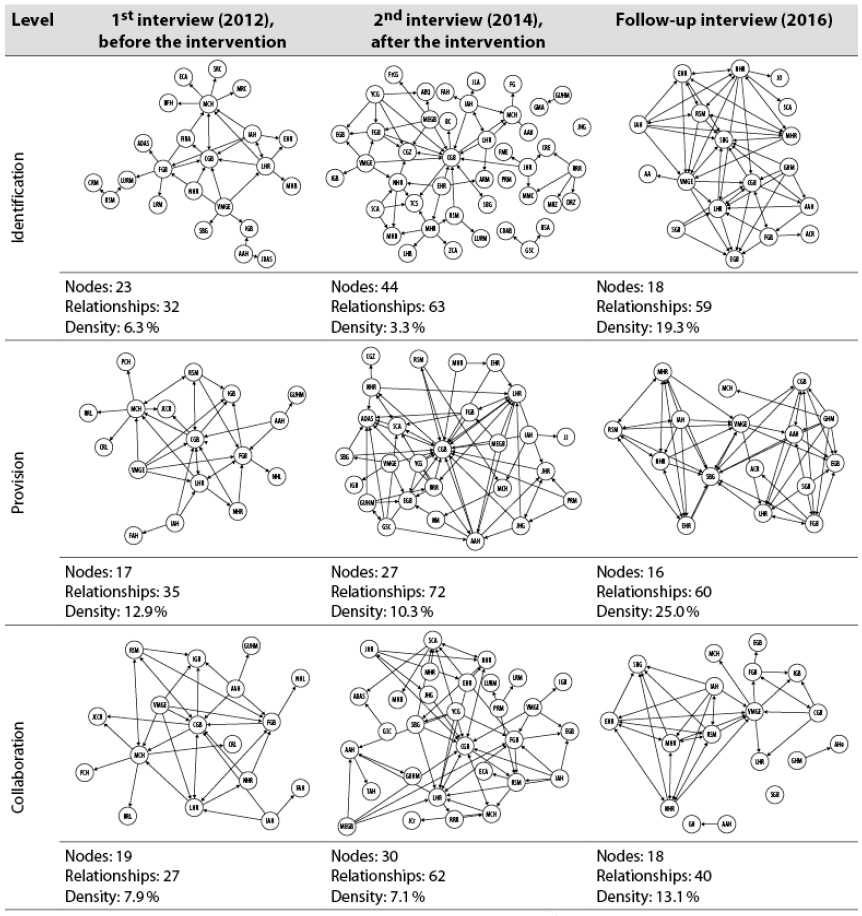
Source: Elaborated by the authors
Table 3 (cont.) The El Refugio citrus fruit grower’s network in Martinez de la Torre, Veracruz
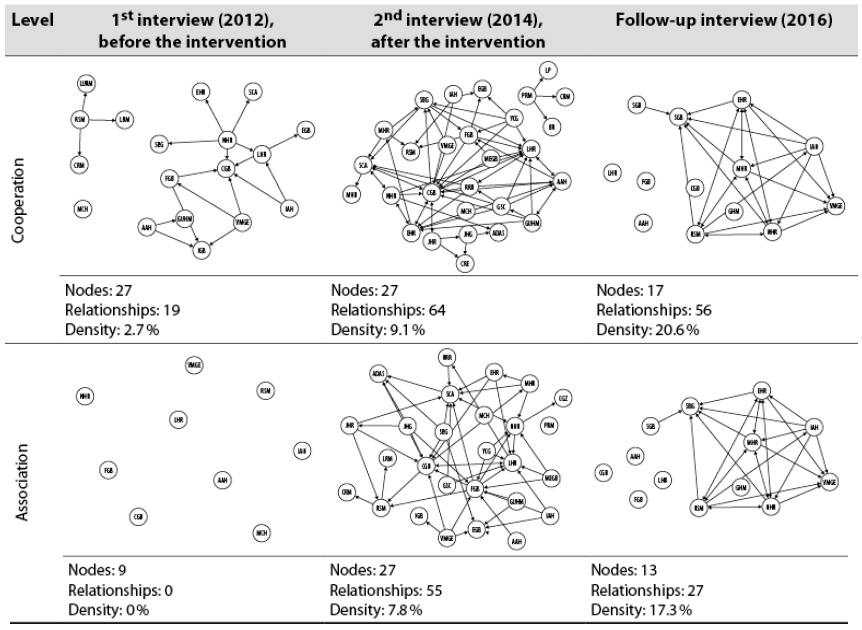
Source: Elaborated by the authors.
Table 4 The El Frijolillo citrus fruit grower’s network in Tuxpan, Veracruz
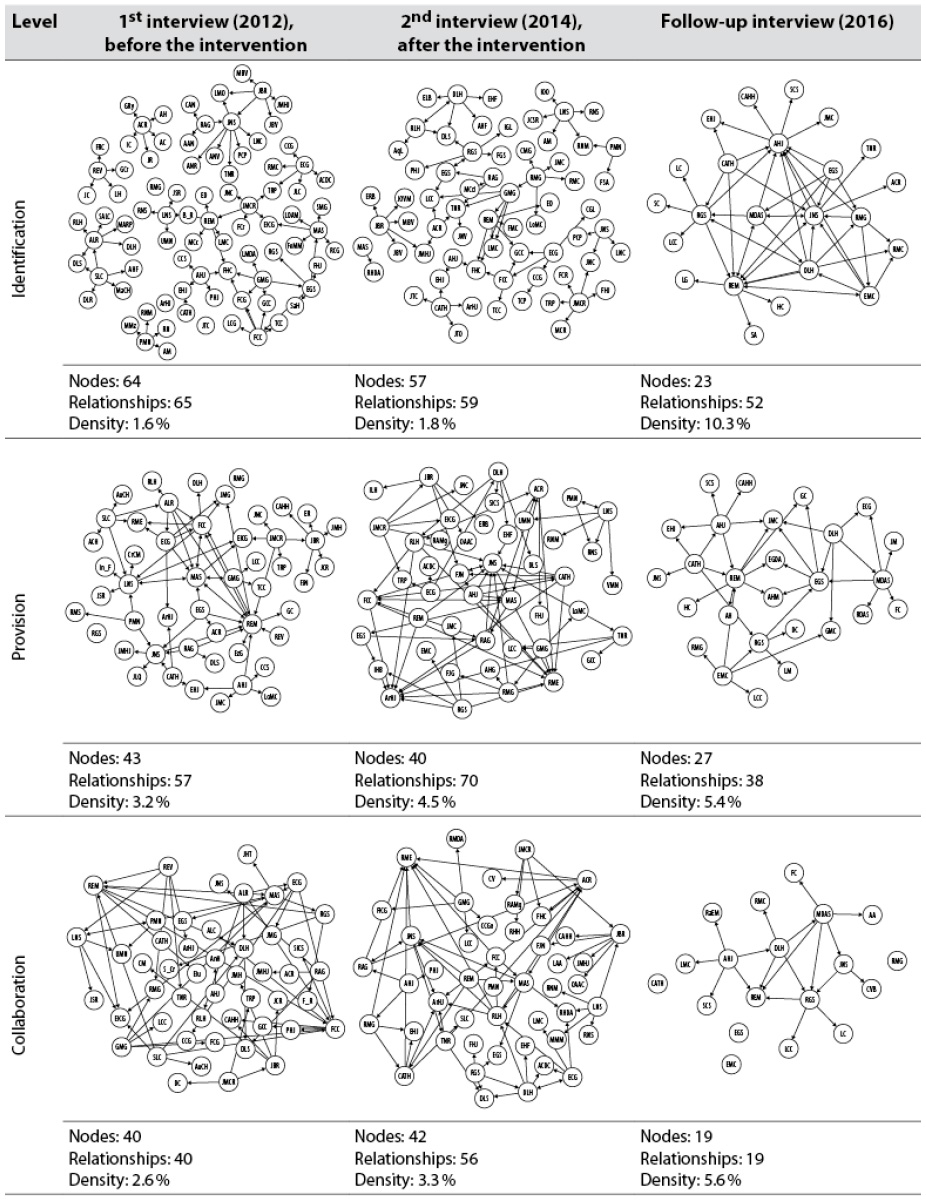
Source: Elaborated by the authors
Table 4 (cont.) The El Frijolillo citrus fruit grower’s network in Tuxpan, Veracruz
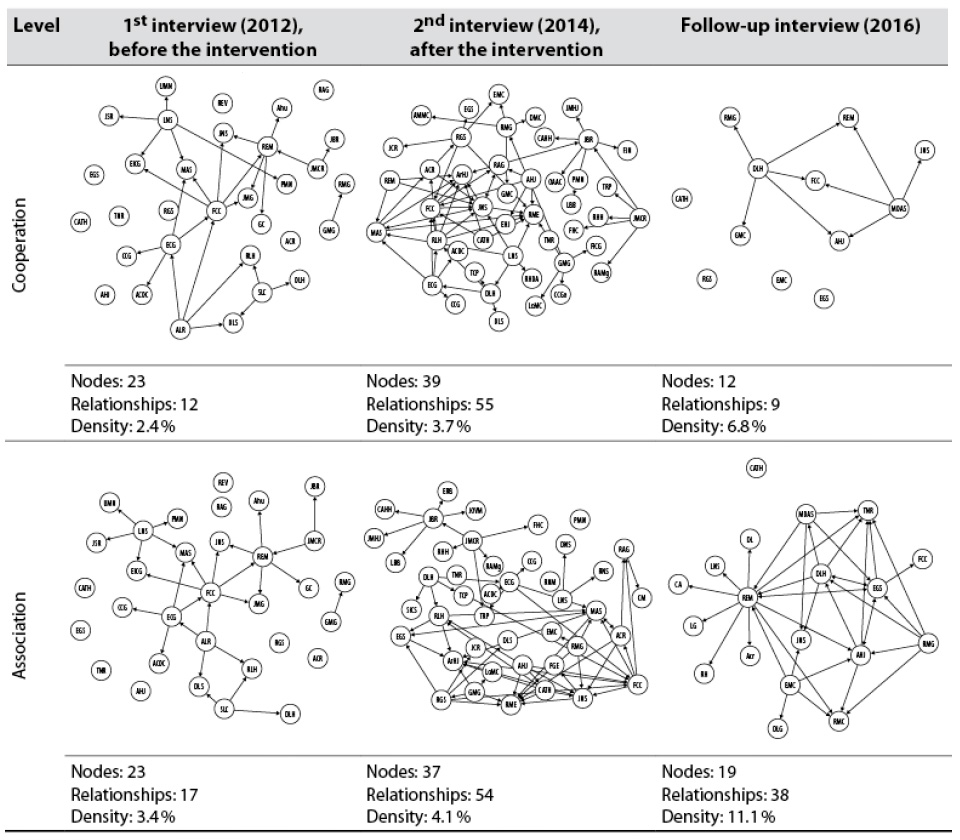
Source: Elaborated by the authors
Table 5 The Hermenegildo Galeana citrus fruit grower’s network in Álamo Temapache, Veracruz
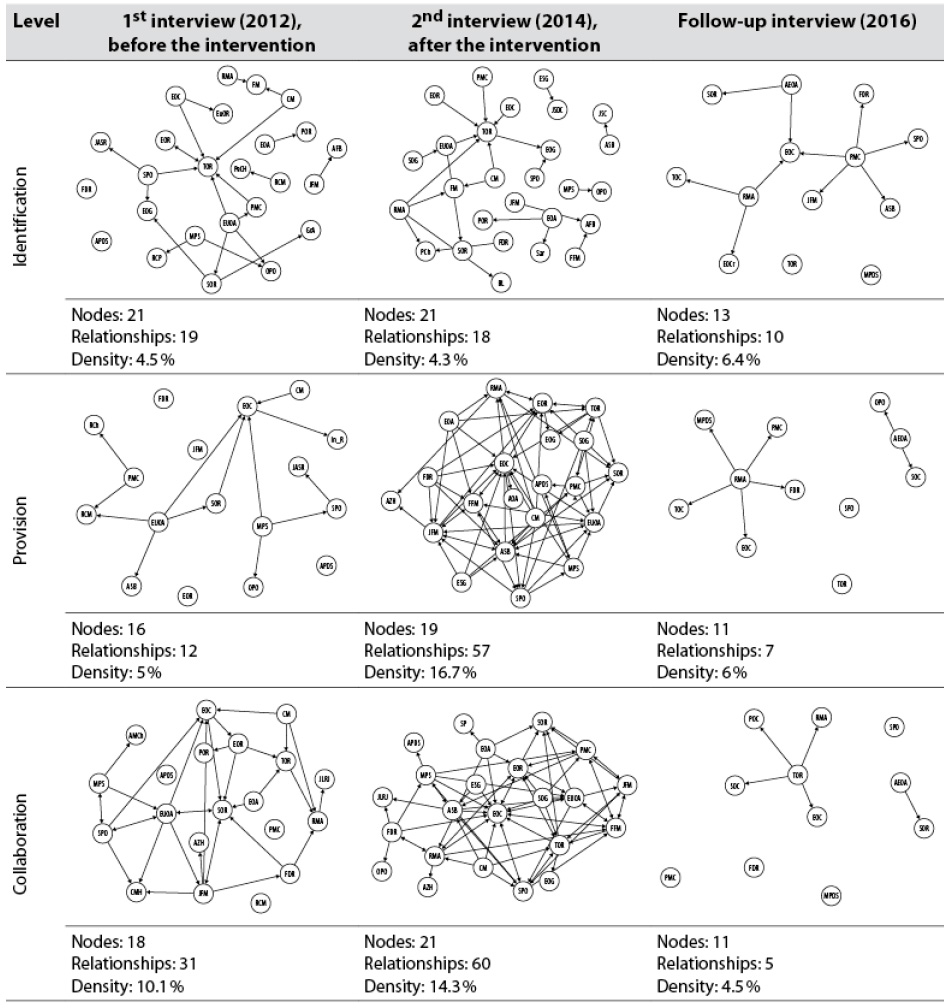
Source: Elaborated by the authors
Table 5 (cont.) The Hermenegildo Galeana citrus fruit grower’s network in Álamo Temapache, Veracruz
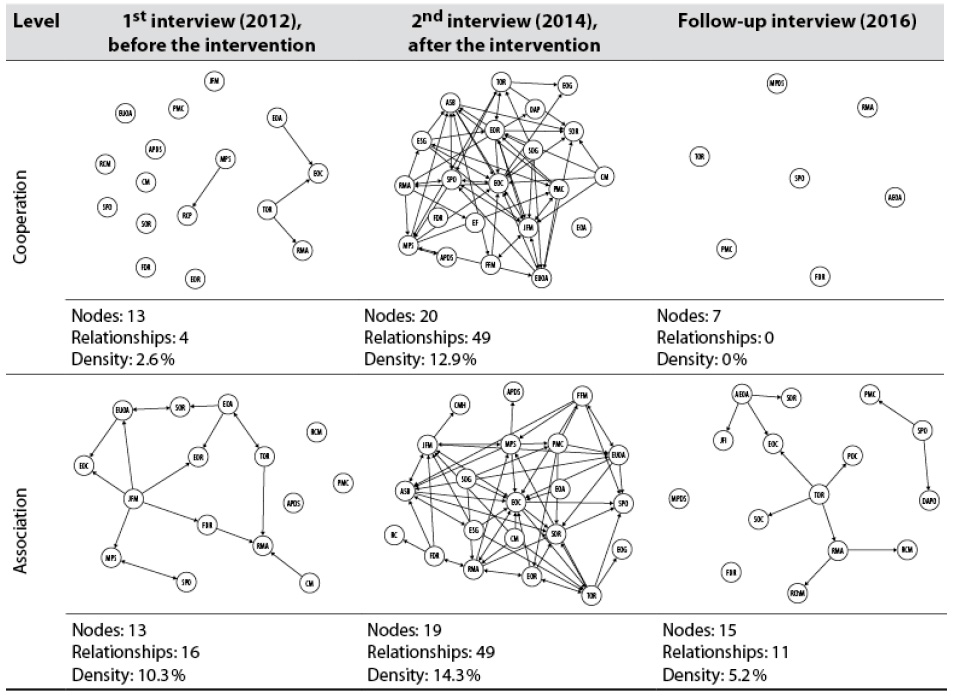
Source: Elaborated by the authors
Table 6 The El Limonar citrus fruit grower’s network in Álamo Temapache, Veracruz
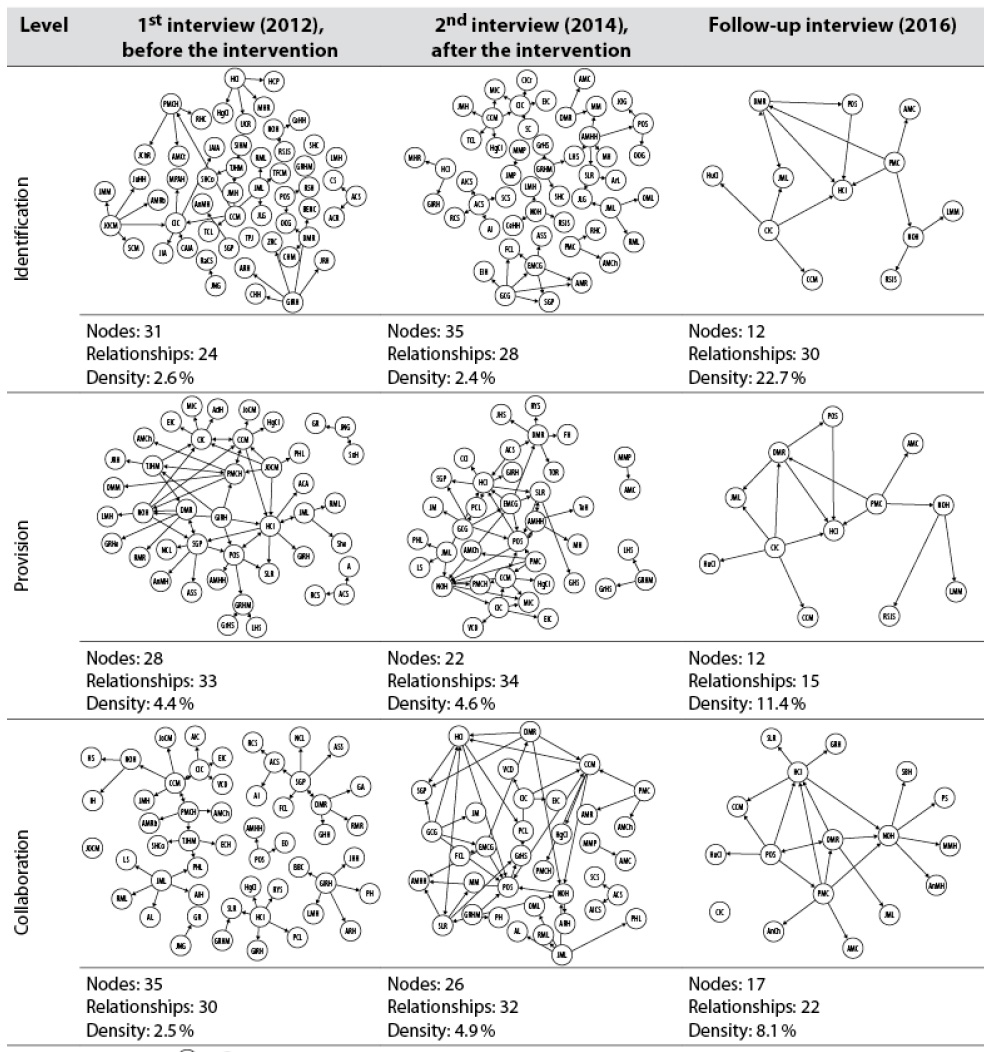
Source: Elaborated by the authors.
Table 6 (cont.) The El Limonar citrus fruit grower’s network in Álamo Temapache, Veracruz
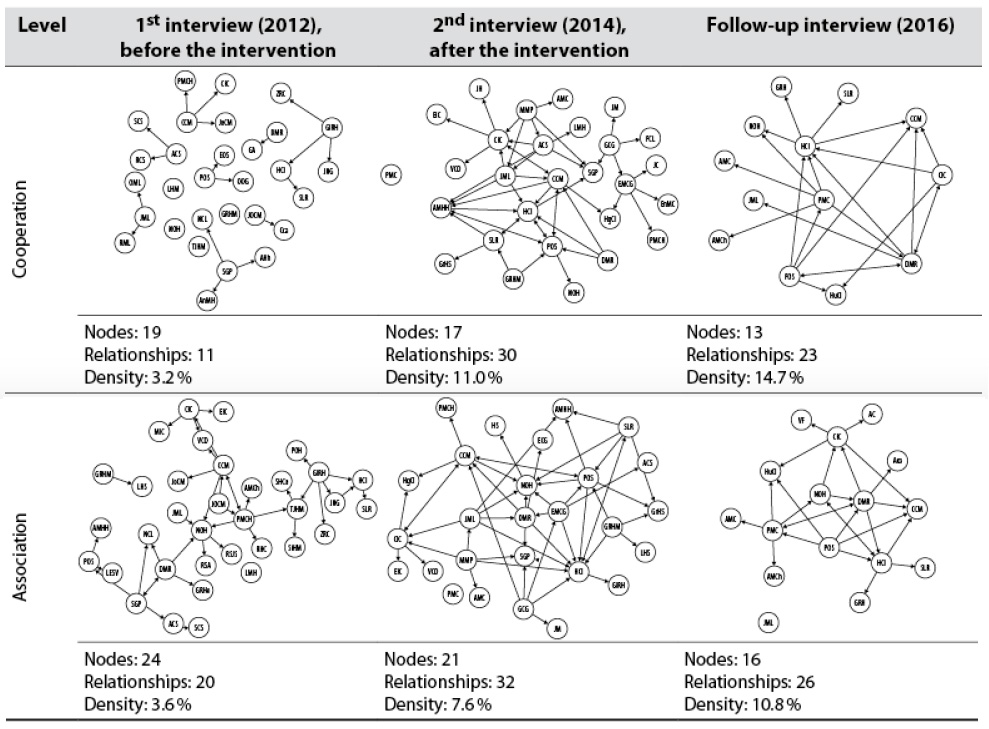
Source: Elaborated by the authors.
Table 7 The La Camelia citrus fruit grower’s network in Álamo Temapache, Veracruz
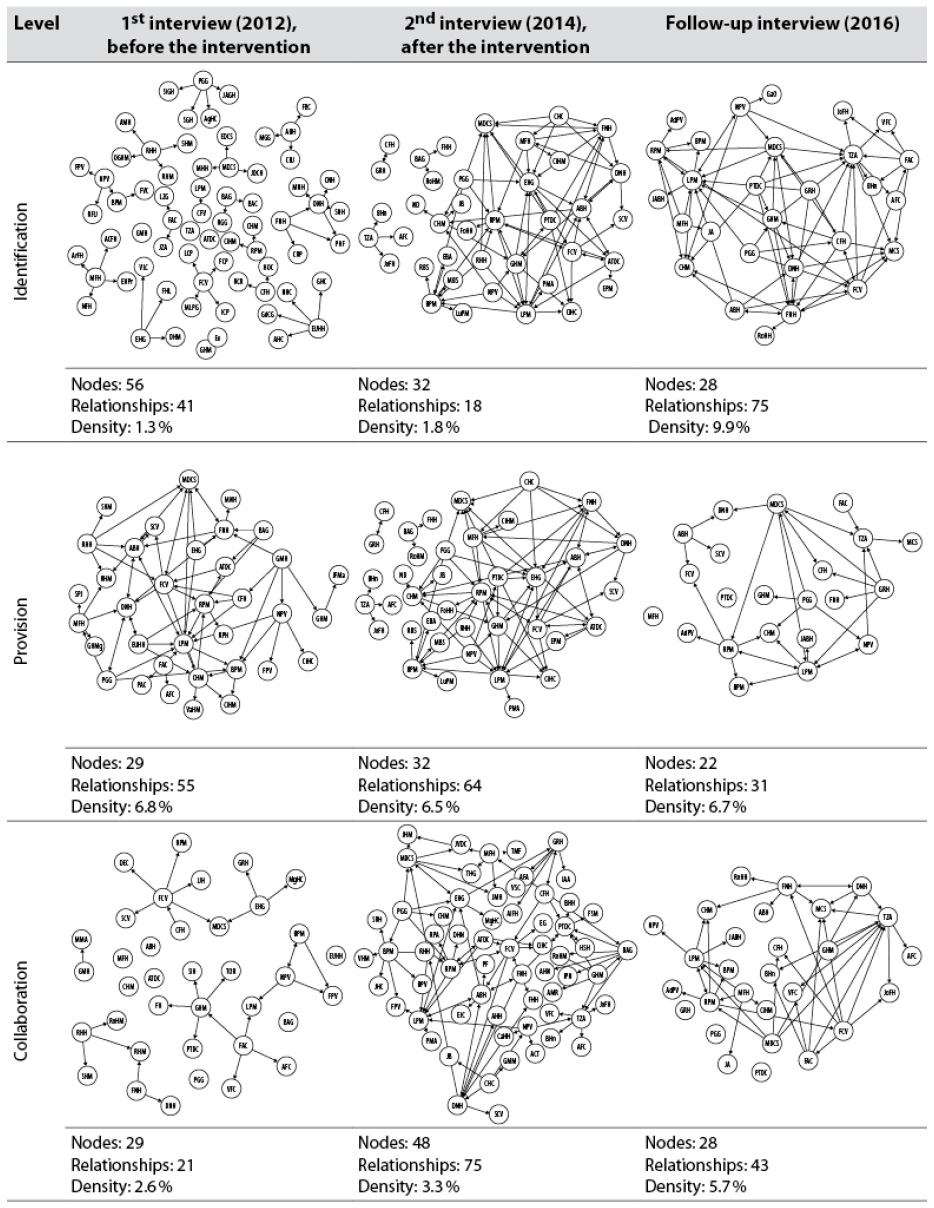
Source: Elaborated by the authors
Table 7 (cont.) The La Camelia citrus fruit grower’s network in Álamo Temapache, Veracruz
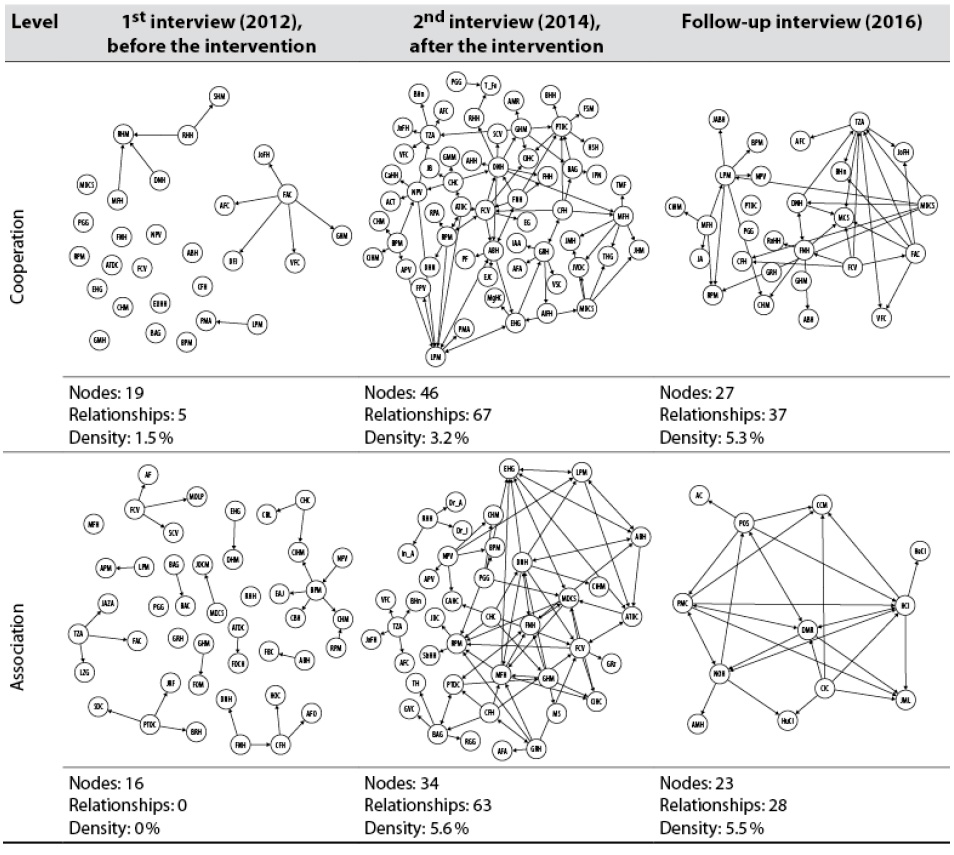
Source: Elaborated by the authors
In the present study, the workshops helped cement relationships among growers, which remained that way over time. In contrast, the networks, especially at the relationship level, such as cooperation and association, were more structured considering that social capital improved.
Sánchez et al. (2016) found that growers directly connected with an extension agent and its aid improved their position in the network, the value of their social indicators (degree and coverage of entry), and their INAI (36.4, p < 0.01), compared to the ones with an indirect connection (23.4, p < 0.01). The correlation between INAI and the value of social indicators was obtained. After two years of having completed the intervention, the INAI drop significantly by 19.1 %, and significant correlations with social indicators were no longer found, implying that the adoption of innovations by growers was not permanent. The extension method used was innovation networks.
Coleman (1990) mentioned that social trust a byproduct of participating associations and civic engagement networks. In our case, trust was strengthened by delivering ten workshops and forming cooperatives. The workshops sought to improve social capital by consolidating collective values such as cooperation, solidarity, and trust and creating communication and exchange contexts among actors, operational guidelines, standards, and values that condition the actors’ behavior. Also, functionally differential positions are crucial to understanding the actors’ behavior within each network and the entire network’s performance, as raised by Aguirre (2011) and Lozares (1996).
Using Rovere (1999) methodology, the results show that the intervened communities have substantially improved their relationships (Table 8), which implies an evolution of the social network. A different behavior was found in the nodes representing the growers involved in identification and provision, compared to collaboration, cooperation, and association, where a considerable decrease is observed at some levels in specific communities. This finding can be attributable to individual growers’ isolation and their indifference to activities aimed at forming robust groups of collective interest. This behavior causes social exclusion, resulting in a selection process within the community.
Zarazúa et al. (2012) compared the yield corn obtained by two types of growers (small- and micro- holders) using social capital indicators; the micro-holder has less than 2.2 hectares, and its production is mainly for self-consumption, while the smallholder has 6–15 hectares and its production is mainly for sale. They found that smallholders had an average yield of 2.3 t/ha, a rate of adoption of innovation of 12.6%, and only reached three levels of trust in the scale of Rovere (1999). Micro-holders obtained a rate of adoption of 48.2% and five levels on the same trust scale. This network was more integrated because it showed higher density, larger size, more links, and lower standard deviation. The centrality index was also lower than in the other network, which refers to the principle of better access to information and knowledge, and production was 2.5 times higher. In the end, 20 cooperatives were formed because of the consolidation of principles and values such as trust, cooperation, solidarity, and the building, strengthening, and consolidation of internal trust (Amézaga et al., 2013).
Table 8 Comparison of means for centrality by community
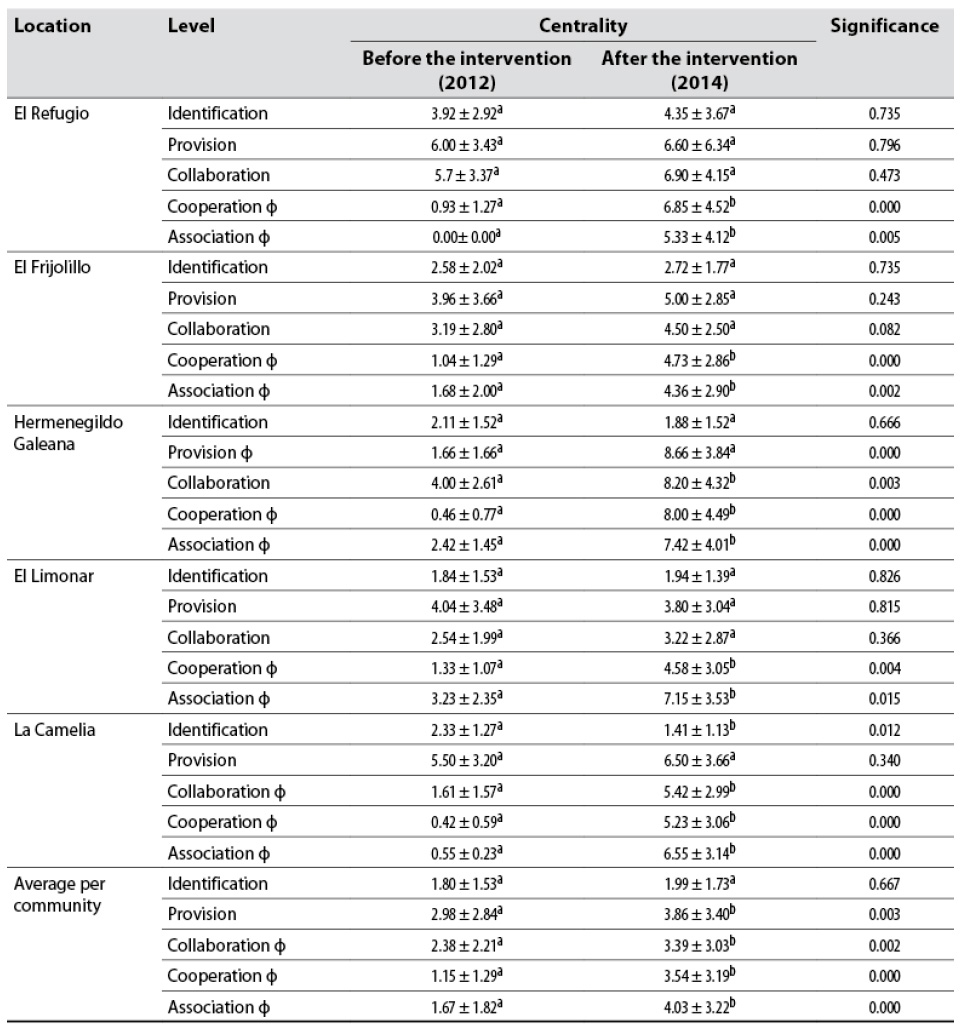
Note. ϕEquality of variances is not assumed, according to Levene’s test (p > 0.05). Different letters (a, b) in the same row refer to a statistical difference according to the t-test for equality of means (p < 0.05).
Source: Elaborated by the authors
The node degree indicator understood as the number of relationships that a particular node has obtained increased, suggesting that establishing quality links contributes to exchanging information and relevant resources that positively influence social capital.
A strategy that could produce positive impacts is working with the so-called “structuring actors” identified in the cooperation and collaboration networks in the final stage (table 9). These “structuring actors” play a fundamental role in shaping networks as opinion leaders and decision-making processes within groups, allowing them to continue consolidating these groups and then undertake more ambitious and far-reaching projects. They are also involved in adopting and disseminating highly beneficial differential innovations in the national citrus fruit production.
Table 9 Structuring actors per deep level linkages after the intervention stage§
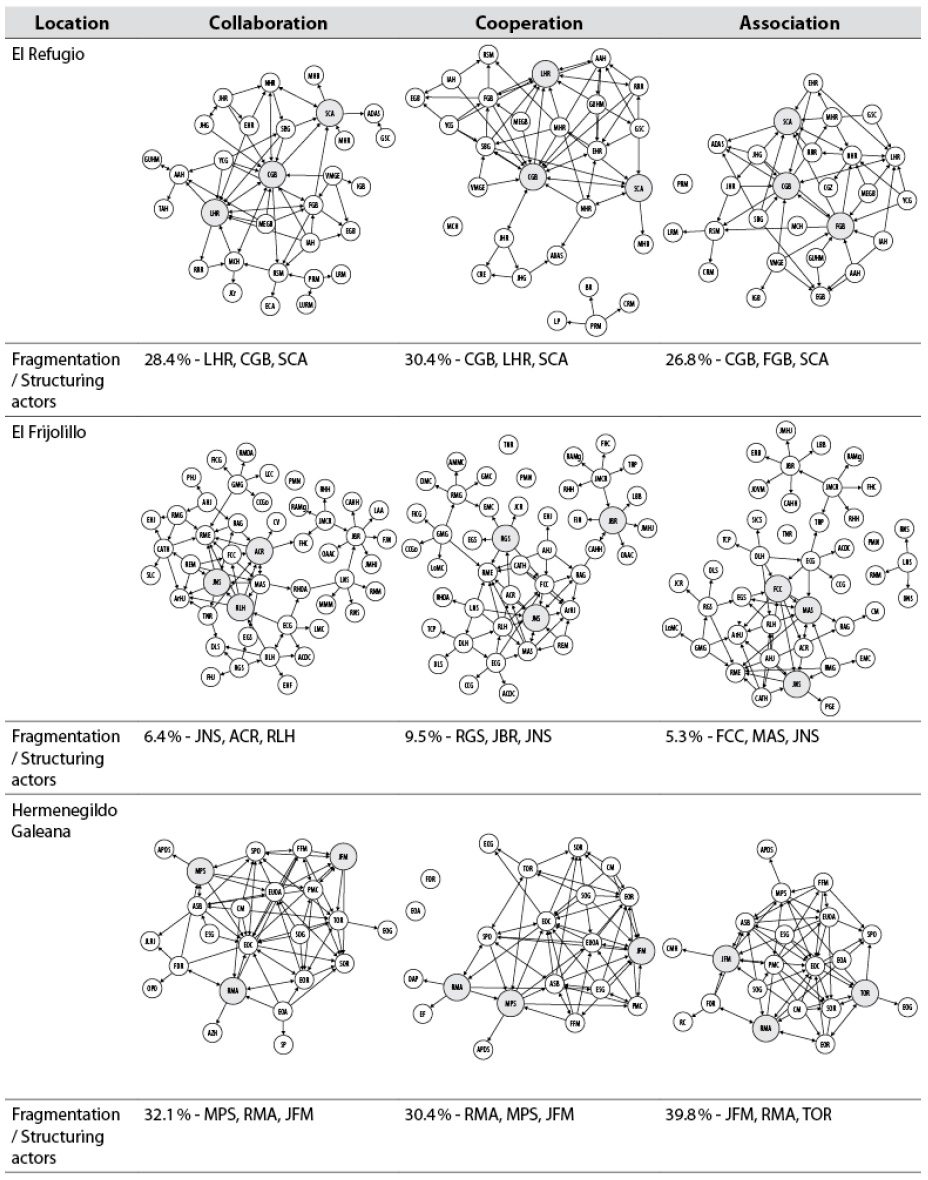
Source: Elaborated by the authors
Table 9 (cont) Structuring actors per deep level linkages after the intervention stage§
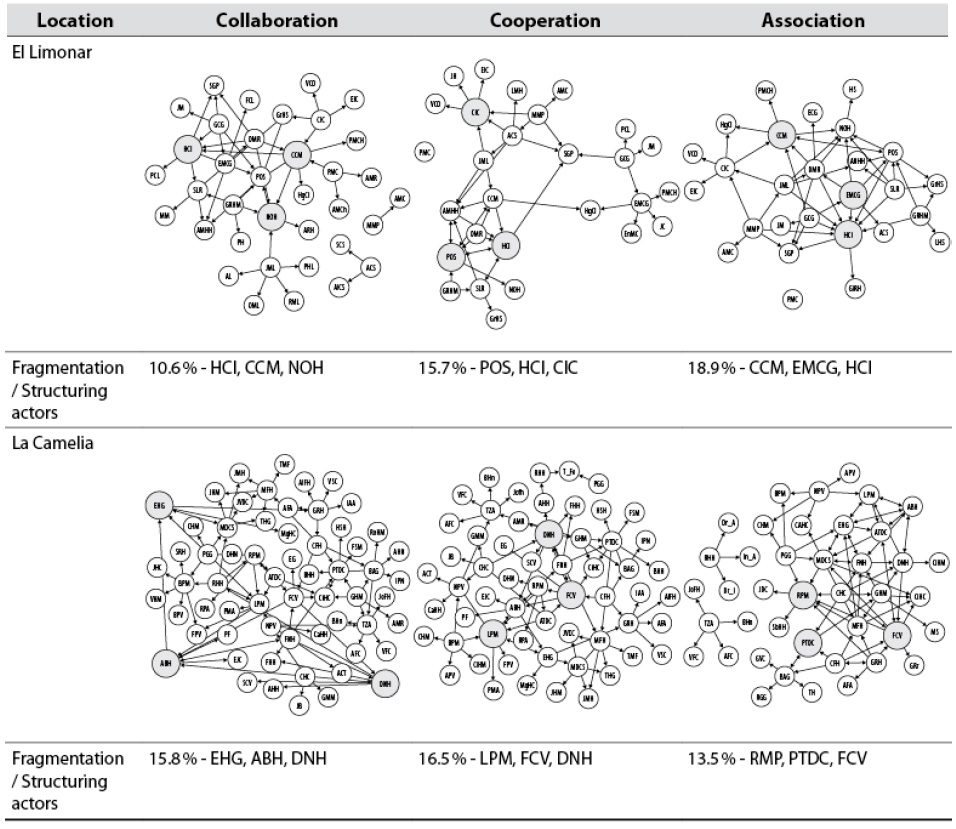
Note.Larger nodes in gray are structuring actors. The percentage of fragmentation was determined at three levels. §Structuring actors: Per location, we identified the three major growers using a three- or four- letter code in each intervention stage.
Source: Elaborated by the authors
The structuring actors in most of the communities remained constant. In general, during the intervention, they were consulted to improve the consolidation of the network. Zarazúa et al. (2012) observed that growers who had a more integrated network, with more structuring actors, higher density, larger size, more links, and lower standard deviation, produced up to 2.5 times more than those who had a disjointed network. It should be mentioned that each group formed established voluntary rules. Also, networks and collective values were promoted, concluding that social capital increased.











 text in
text in 



